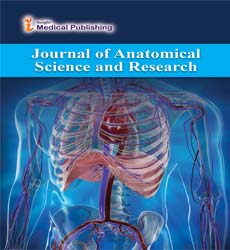Three-dimensional Imaging in the Assessment of Craniofacial Growth and Development
Hans Muller*
Department of Clinical Anatomy and Cell Analysis, University of Tübingen, Tübingen, Germany
*Corresponding Author:
Hans Muller,
Department of Clinical Anatomy and Cell Analysis, University of Tübingen, Tübingen, Germany,
E-mail- hans.mueller@ugen.de
Received date: February 03, 2025; Accepted date: February 05, 2025; Published date: February 28, 2025
Citation: Muller H (2025) Three-dimensional Imaging in the Assessment of Craniofacial Growth and Development. J Anat Sci Res Vol: 8 No: 1: 03
Introduction
The evaluation of craniofacial growth and development has long been a central concern in orthodontics, maxillofacial surgery, and pediatric craniofacial medicine. Traditional imaging modalities such as lateral and posteroanterior cephalograms have provided valuable two-dimensional information for decades. However, the inherent limitations of 2D methods, including distortion, magnification errors, and the inability to visualize complex structures in three dimensions, have driven the adoption of advanced imaging techniques. Three-dimensional imaging has revolutionized the field, offering unprecedented accuracy in assessing craniofacial morphology, growth patterns, and treatment outcomes. The most widely used 3D imaging modalities include cone-beam computed tomography, magnetic resonance imaging, and 3D surface scanning. Each of these technologies provides unique advantages in visualizing skeletal, dental, and soft tissue structures. CBCT has become particularly popular in orthodontics and maxillofacial surgery due to its high-resolution imaging of bony structures with relatively lower radiation doses compared to conventional CT. MRI, on the other hand, is invaluable in assessing soft tissue without ionizing radiation, making it an attractive option for pediatric populations [1].
Description
One of the greatest strengths of 3D imaging lies in its ability to provide volumetric data, enabling the analysis of craniofacial structures from any angle. This allows clinicians to accurately assess asymmetries, growth discrepancies, and spatial relationships that may not be apparent on 2D images. For example, subtle mandibular asymmetries or orbital discrepancies can be visualized and quantified with high precision, aiding in early diagnosis and treatment planning. 3D imaging also allows for longitudinal tracking of craniofacial growth. By capturing sequential scans over time, clinicians can evaluate the dynamic changes that occur during growth and development. Longitudinal data also supports more accurate timing of surgical and orthodontic interventions [2].
In orthodontics, 3D imaging provides critical insights into the relationships between teeth, alveolar bone, and surrounding structures. Unlike 2D cephalograms, CBCT enables clinicians to visualize root angulations, alveolar bone thickness, and airway dimensions in detail. This facilitates precise treatment planning for tooth movement, implant placement, and evaluation of airway-related issues in conditions such as obstructive sleep apnea. The role of 3D imaging in surgical planning cannot be overstated. Virtual surgical planning relies heavily on CBCT datasets, which can be combined with 3D facial scans to simulate osteotomies, bone repositioning, and reconstruction. These simulations provide surgeons with predictive outcomes and allow for custom fabrication of surgical guides and implants. In complex craniofacial reconstructions, such integration enhances both precision and efficiency while reducing operative time and complications [3].
3D surface imaging also plays a crucial role in non-invasive assessment of soft tissue morphology. Techniques such as stereophotogrammetry and laser scanning provide accurate facial surface data without radiation exposure. These are particularly beneficial in pediatric populations for monitoring facial growth, evaluating surgical outcomes, and documenting craniofacial anomalies. They also enable objective quantification of facial symmetry and esthetics, which is important for both clinical and psychosocial outcomes [4].
The integration of 3D imaging with computational modeling has opened new avenues in growth prediction. Finite element analysis and machine learning algorithms can process 3D datasets to simulate craniofacial growth and treatment outcomes. Such predictive models hold the potential to personalize treatment timing and modalities based on individual growth trajectories, moving closer to precision medicine in craniofacial care. Despite its many advantages, 3D imaging is not without limitations. Radiation exposure from CBCT remains a concern, particularly in children, where cumulative dose must be minimized. Cost, accessibility, and the need for specialized training in interpretation also limit widespread adoption in some regions [5].
Conclusion
Three-dimensional imaging has transformed the assessment of craniofacial growth and development by providing accurate, comprehensive, and dynamic visualization of skeletal and soft tissue structures. Its applications span diagnosis, longitudinal growth monitoring, orthodontic planning, and surgical simulation, offering a level of precision previously unattainable with 2D methods. While challenges remain in terms of radiation safety, cost, and standardization, ongoing technological and computational advances are likely to overcome these barriers. As 3D imaging becomes increasingly integrated into clinical workflows, it holds the promise of improving diagnostic accuracy, personalizing treatment, and enhancing outcomes for patients with both normal and abnormal craniofacial growth patterns.
Acknowledgement
None.
Conflict of Interest
None.
References
- Jankowska A, Janiszewska-Olszowska J, Grocholewicz, K. (2021). Nasal morphology and its correlation to craniofacial morphology in lateral cephalometric analysis. Int J Environ Res Public Health18: 3064.
Google Scholar Cross Ref Indexed at
- Ocak Y, Cicek O, Ozkalayci N, Erener H. (2023). Investigation of the relationship between sagittal skeletal nasal profile morphology and malocclusions: A lateral cephalometric film study. Diagnostics13: 463.
Google Scholar Cross Ref Indexed at
- Wroblewski ME, Bevington J, Badik C. (2015). Head growth.
Google Scholar Cross Ref Indexed at
- Cheikh Ismail L, Knight HE, Ohuma EO, Hoch L, Chumlea WC, et al. (2013). Anthropometric standardisation and quality control protocols for the construction of new, international, fetal and newborn growth standards: The intergrowthâ?21st Project. BJOG120: 48-55.
Google Scholar Cross Ref Indexed at
- Küchler EC, Scariot R, Kirschneck C. (2021). Craniofacial growth and development: Novel insights. Front Cell Dev Biol9: 744711.
Open Access Journals
- Aquaculture & Veterinary Science
- Chemistry & Chemical Sciences
- Clinical Sciences
- Engineering
- General Science
- Genetics & Molecular Biology
- Health Care & Nursing
- Immunology & Microbiology
- Materials Science
- Mathematics & Physics
- Medical Sciences
- Neurology & Psychiatry
- Oncology & Cancer Science
- Pharmaceutical Sciences
